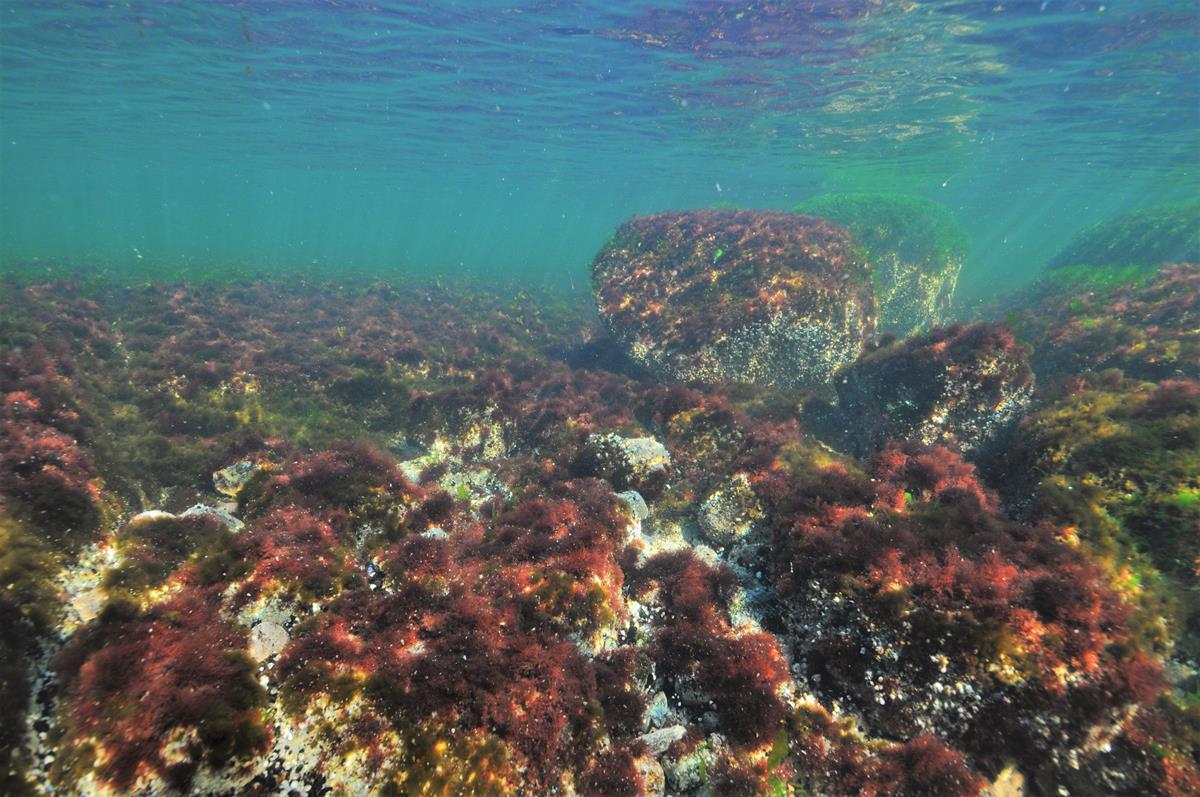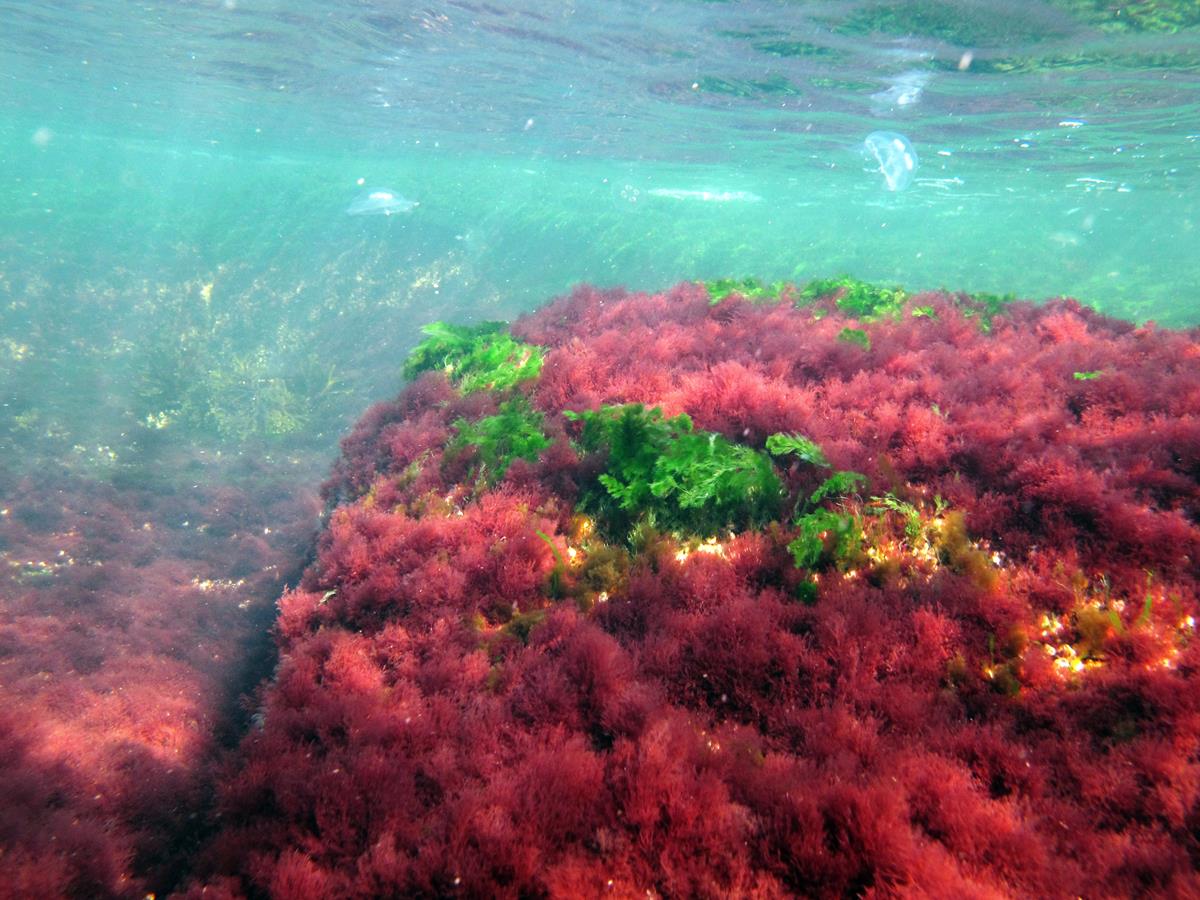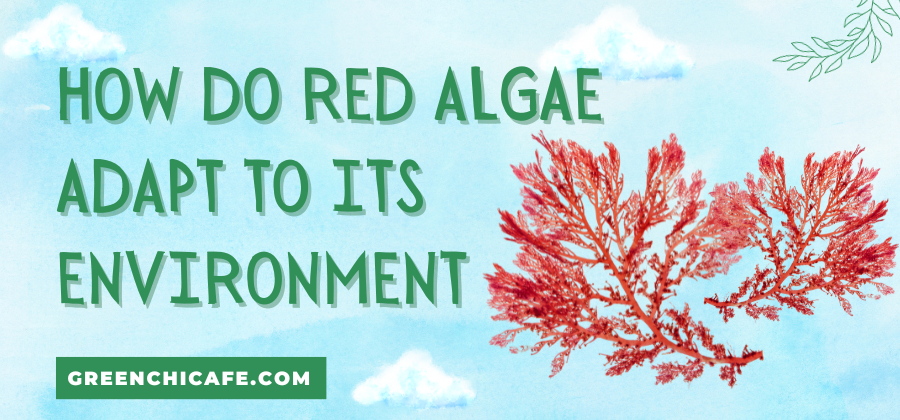Last Updated on June 3, 2024 by Annie Baldwin
Red algae are a fascinating group of organisms that have evolved a variety of strategies to thrive in marine environments.
Their reddish color comes from the pigment phycoerythrin, which helps them absorb blue light that penetrates deeper in water.
Let’s explore how these adaptable seaweeds cope with varying light, salinity, and other challenges.
How Do Red Algae Adapt to Its Environment?

Red algae have evolved a variety of adaptations to thrive in ocean environments.
They produce pigments like phycoerythrin to absorb beneficial wavelengths of light.
Compounds like glycogen and antioxidants protect against stress.
Adhering to surfaces and forming dense mats prevents being swept away.
Cell walls adapted to handle salinity changes allow inhabiting diverse marine habitats.
Overall, red algae are resilient organisms with specialized adaptations for life in the sea.
Key Points
- Produce protective pigments and compounds
- Adhere to surfaces and form dense mats
- Cell walls adapted for salinity tolerance
Our Opinion
Red algae are remarkably adapted organisms.
Their resilience and ability to thrive in challenging marine environments are impressive.
The protective strategies and specialized adaptations of red algae allow them to inhabit diverse ocean habitats.
We believe red algae represent one of evolution’s ingenious solutions for life in the sea.
How Red Algae Adapt to Different Light Environments

Red algae grow across a range of ocean depths, from shallow waters to over 250 meters down. To adapt to lower light levels, some species produce more phycoerythrin to supplement chlorophyll and enhance light absorption. Others store extra ribosomes to ramp up protein production when light is available.
Some red algae species can modify their photosynthetic systems based on light intensity. In bright shallows, they use a more energy-intensive process. In dim waters, they switch to a more efficient system that captures less light but works better in those conditions.
Additionally, red algae distribute their pigments and chloroplasts in different ways depending on light exposure. Some spread out chloroplasts to catch more light in dark areas. Others cluster chloroplasts to prevent overexposure in bright zones.
Through these clever adaptations, red algae thrive across the light gradients of the oceans. Their flexibility allows them to optimize photosynthesis and growth in both harsh shallows and in the diminishing light of the mesopelagic zone.
Red Algae’s Adaptive Responses to Temperature Changes
Red algae inhabit oceans across the globe, from frigid polar regions to tropical waters. To cope with temperature fluctuations, they have evolved special adaptations.
Some red algae produce heat shock proteins that prevent protein denaturation when temperatures spike. This helps them survive short-term heat waves.
Certain red algae species can change the fluidity of their cell membranes in response to cooling. By increasing membrane rigidity, they prevent membranes from solidifying and provide stability in colder conditions.
Some Antarctic red algae species have antifreeze proteins that bind to ice crystals and prevent recrystallization. This stops ice from enlarging and damaging cells.
Through circadian rhythms, some red algae regulate their metabolism to anticipate temperature changes between night and day. This maximizes growth and saves energy.
With such adaptive mechanisms, red algae thrive across diverse thermal environments. Their temperature resilience allows them to inhabit the poles as well as the tropics.
Adaptations Enabling Red Algae to Thrive in Aquatic Habitats

Red algae have evolved a variety of adaptations that allow them to thrive in marine and freshwater habitats.
Many species contain the red pigment phycoerythrin, which enables photosynthesis at greater depths than other algae by absorbing blue light that penetrates deeper in water.
Some red algae can tolerate a wide range of salinities, enabling them to inhabit estuaries where salt and fresh water mix.
Many red algae have complex life cycles with both sexual and asexual stages. This provides reproductive flexibility to disperse gametes and spores to colonize new areas.
Filamentous and calcified forms provide structure and protection from waves and currents. This allows red algae to inhabit intertidal zones pounded by surf.
As evidenced by their global distribution, red algae have evolved a versatile toolbox of adaptations to not just survive, but thrive in diverse aquatic conditions.
Survival Mechanisms of Red Algae in Extreme Environments
Red algae have developed specialized mechanisms that enable them to survive in some of the harshest aquatic environments on Earth.
Many red algae produce ribosomal stores of proteins and carbohydrates that act as a food reserve when conditions are unfavorable. This provides energy until the environment improves again.
Some species tolerate extreme temperatures, from freezing to hot hydrothermal vents. Heat shock proteins help stabilize cell function at high temps.
Red algae can modify their photosynthetic systems to maximize efficiency in low light. Some also associate with symbiotic bacteria that can provide supplemental nutrition.
The ability to tolerate high levels of UV radiation allows red algae to live at the surface in tropical regions. UV-absorbing compounds help limit DNA damage.
Through adaptations like these, red algae display remarkable resilience in some of the harshest marine and freshwater habitats on the planet.
The unique pigments of red algae play a key role in their adaptive abilities.
Red algae contain chlorophyll a, but also phycoerythrin, which gives them their distinctive coloration. This pigment allows red algae to photosynthesize and thrive in blue light environments, like deeper waters.
Some species also contain phycocyanin, which expands their light-harvesting capabilities even further. With more flexible pigment combinations, red algae can thrive across a broader range of aquatic habitats.
In addition, some red algae produce UV-absorbing mycosporine-like amino acids (MAAs). These compounds act as a natural sunscreen, allowing red algae to tolerate high UV conditions near the surface.
The unique pigments of red algae have clearly played a key evolutionary role. By expanding their light-harvesting and UV protection abilities, these pigments allow red algae to inhabit diverse aquatic environments where other algae cannot survive.
FAQ
How Does Red Algae Survive?
Red algae survive through a variety of adaptations. They produce protective pigments like phycoerythrin to absorb blue light and reflect red light. They also produce compounds like glycogen and antioxidants to deal with environmental stressors. Many species adhere to surfaces or form dense mats to avoid being swept away by waves and currents.
How Have Red Algae Adapted to the Ocean Biome?
Red algae have adapted to the ocean through strategies like adhering to surfaces, forming dense mats, and producing pigments and protective compounds. Their cell walls have also adapted to handle salinity changes. Some species can survive across a wide range of salt concentrations.
How Does Algae Survive in Its Environment?
Algae survive through adaptations like producing protective pigments, forming dense colonies, adhering to surfaces, and developing salt tolerance. Their simple cellular structure allows them to reproduce quickly. Some algae form spores or thick cell walls to shield themselves from harsh conditions.
Why Didn’t Red Algae Adapt to Land?
Red algae did not adapt to land because they require water for reproduction and survival. Their cells are adapted for absorbing nutrients from water, not from air or soil. Without the buoyancy of water, red algae would not thrive. The harsh ultraviolet radiation on land would also damage their cells.
Conclusion
Red algae have evolved a variety of adaptations that allow them to thrive in marine environments. They produce protective pigments and compounds to handle environmental stresses. Strategies like adhering to surfaces and forming dense mats prevent them from being swept away by waves and currents. Their ability to survive across a range of salt concentrations enables red algae to inhabit diverse ocean habitats. Understanding how red algae adapt to their surroundings provides insights into the resilience of these ancient organisms.
